Overview
Query and Mutation aren't the only types in GraphQL—when we want real-time updates about server-side events, we'll need the third and final GraphQL type: the Subscription!
In this lesson, we will:
- Configure
ApolloClientto use WebSockets - Write a subscription operation to receive booking notifications
- Test the subscription in-app
Apollo Kotlin and subscriptions
With subscriptions, we can get notifications about real-time events as they happen. We'll spend this last lesson of the course exploring how we can build a subscription operation to receive a notification when someone books a seat on a launch! 🚀
Apollo Kotlin supports WebSockets and Multipart HTTP for subscriptions. For this tutorial we'll use WebSockets.
Note: To learn more about Multipart HTTP, see Multipart HTTP protocol for GraphQL Subscriptions.
Let's create a subscription!
Open up Sandbox, or use the embedded Explorer in the collapsible section below.
Click on the Schema tab at the far left. In addition to queries and mutations, we'll find a third operation type, Subscription. Click on Subscription to see the tripsBooked field:
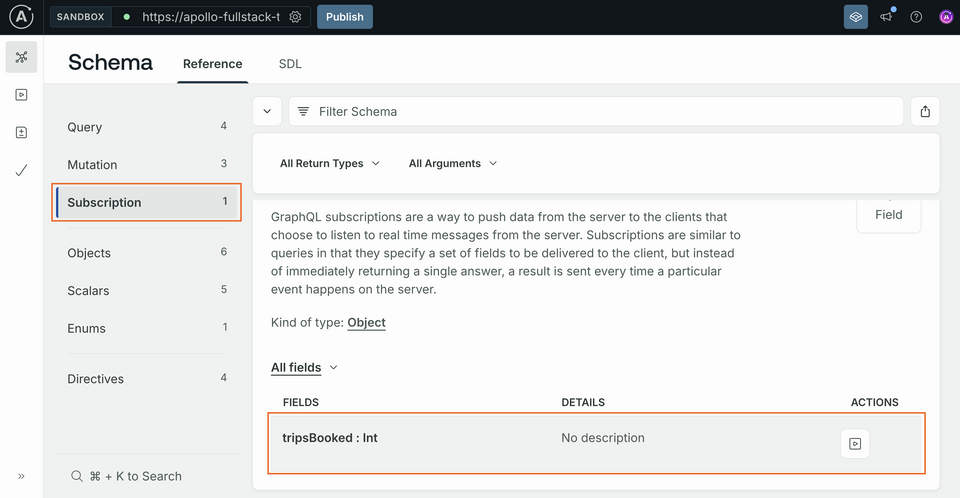
This subscription doesn't take any arguments and returns a single scalar named tripsBooked. Since we can book multiple trips at once, tripsBooked is an Int. It will contain the number of trips booked at once or -1 if a trip has been cancelled.
Click the play button to the far right of tripsBooked to open the subscription in Explorer. Open a new tab, then check the tripsBooked button to have the subscription added:
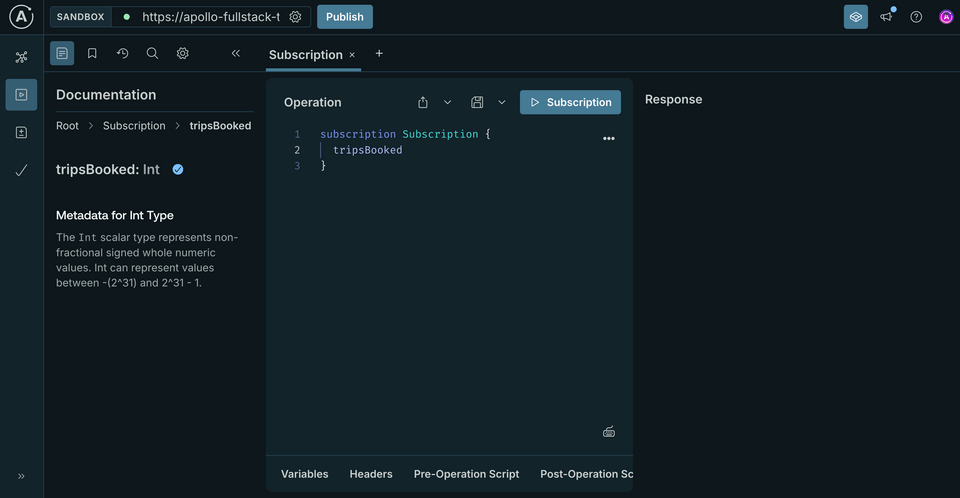
Again, we'll rename the subscription so it's easier to find:
subscription TripsBooked {tripsBooked}
Click the Submit Operation button, and the subscription will start listening to events. We can tell it's up and running because a panel will pop up at the lower right where subscription data will come in:
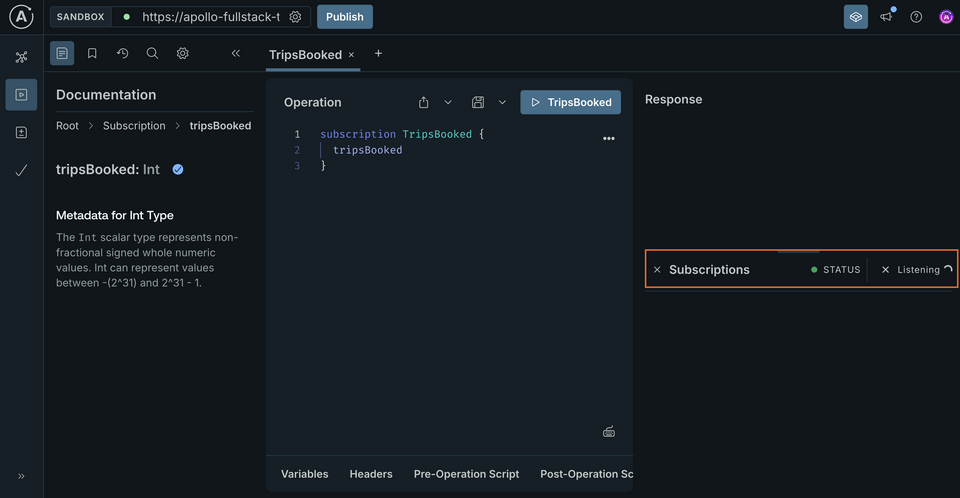
Test your subscription
Open a new tab in Explorer. In this new tab, add code to book a trip like in the previous lesson, but with a hard-coded ID:
mutation BookTrip {bookTrips(launchIds: ["93"]) {message}}
Don't forget to include the authentication header! Make sure the Headers section in the Operation panel is populated with your token.
bWVAZXhhbXBsZS5jb20=
Click the Submit Operation button. If everything went well, we've just booked a trip! At the top of the right panel, we'll see the success JSON for our BookTrip mutation, and below it, updated JSON for the TripsBooked subscription:
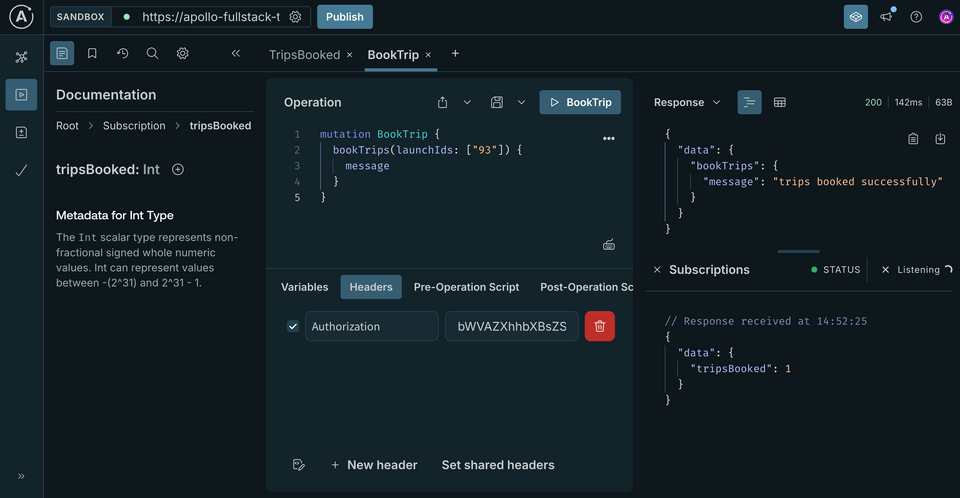
Continue booking and/or canceling trips! We'll see events arriving in the subscription panel in real time. After some time, the server might close the connection and you'll have to restart your subscription to keep receiving events.
Add the subscription to your project
Now that your subscription is working, add it to your project. Create a file named TripsBooked.graphql next to schema.graphqls and your other GraphQL files and paste the contents of the subscription. The process is similar to what you did for queries and mutations:
subscription TripsBooked {tripsBooked}
Don't forget to run a build!
Configure ApolloClient to use subscriptions
This lesson uses the subscriptions-transport-ws protocol for subscriptions. For more options like the newer graphql-ws or Appsync, see GraphQL over WebSocket protocols.
In Apollo.kt, configure a webSocketServerUrl for your ApolloClient:
val apolloClient = ApolloClient.Builder().serverUrl("https://apollo-fullstack-tutorial.herokuapp.com/graphql").webSocketServerUrl("wss://apollo-fullstack-tutorial.herokuapp.com/graphql").okHttpClient(...).build()
Now, we're ready to actually use our subscription!
Use the subscription
In MainActivity, register your subscription and keep a reference to the returned coroutine Flow.
Use collectAsState to get the latest value of the Flow as a state. When the Flow emits a value, it will be stored in tripBookedResponse and trigger a recomposition of the UI thanks to the LaunchedEffect that depends on it.
RocketReserverTheme {val tripBookedFlow = remember { apolloClient.subscription(TripsBookedSubscription()).toFlow() }val tripBookedResponse: ApolloResponse<TripsBookedSubscription.Data>? by tripBookedFlow.collectAsState(initial = null)LaunchedEffect(tripBookedResponse) {if (tripBookedResponse == null) return@LaunchedEffectval message = when (tripBookedResponse!!.data?.tripsBooked) {null -> "Subscription error"-1 -> "Trip cancelled"else -> "Trip booked! 🚀"}// TODO use the message}
Now let's display the message in a Material SnackBar.
To do this, you'll need to create a SnackbarHostState and call showSnackbar on it. Don't forget to also pass it to the Scaffold below:
val snackbarHostState = remember { SnackbarHostState() }val tripBookedFlow = (...)(...)val message = (...)snackbarHostState.showSnackbar(message = message,duration = SnackbarDuration.Short)}Scaffold(topBar = { TopAppBar({ Text(stringResource(R.string.app_name)) }) },snackbarHost = { SnackbarHost(snackbarHostState) },) { paddingValues ->
Handle errors
Like for queries and mutations, the subscription will throw an error if the connection is lost or any other protocol error happens. To handle these situations, you can configure the client to retry the subscription with the webSocketReopenWhen function. Return true to retry, false to stop. To avoid retrying too often, you can use the attempt parameter to delay the retry:
val apolloClient = ApolloClient.Builder()(...).webSocketReopenWhen { throwable, attempt ->Log.d("Apollo", "WebSocket got disconnected, reopening after a delay", throwable)delay(attempt * 1000)true}
Test your subscription in-app
Build and run the application: now whenever a trip is booked or cancelled (from either in the app detail view or from Apollo Sandbox) we should see a small notification pop up at the bottom of the screen:
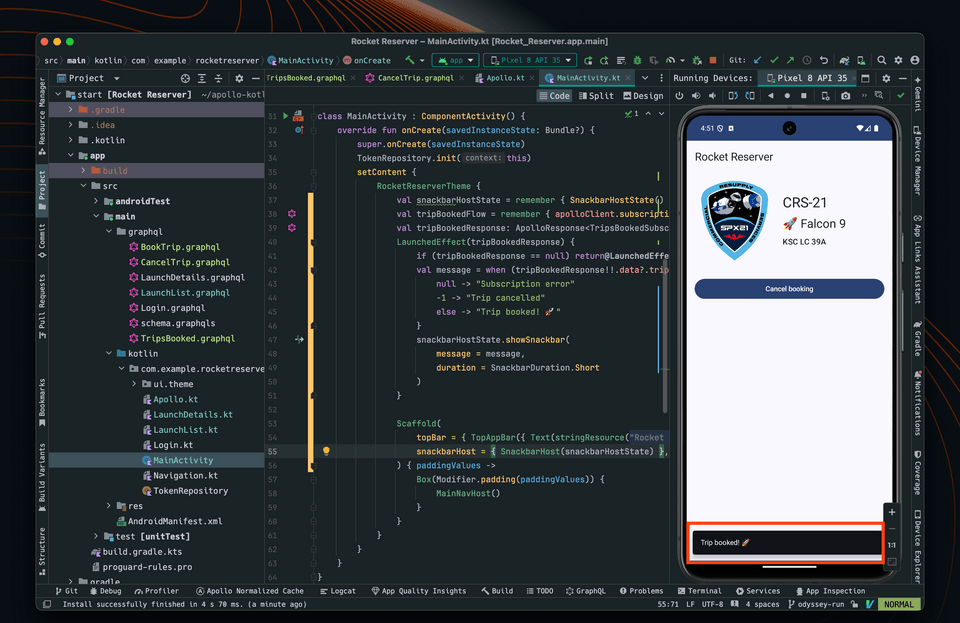
Practice
Journey's end
Congratulations on completing the two-part Apollo Kotlin and Android series! You've successfully learned the basics of the Apollo Kotlin SDK to connect your Android app to a GraphQL server. You have:
- Downloaded a schema
- Added code generation into your workflow
- Written and executed queries and mutations in Apollo Sandbox and in your app
- Learned how to handle errors
- Used basic authentication
- Implemented basic pagination
- Worked with WebSockets subscriptions to receive real-time updates
So, what's next? Keep your progress going! Check out these resources:
Feel free to ask questions by joining the Apollo community forums.
Thank you for choosing Odyssey!
Share your questions and comments about this lesson
This course is currently in
You'll need a GitHub account to post below. Don't have one? Post in our Odyssey forum instead.